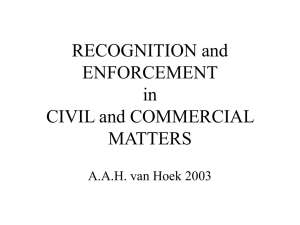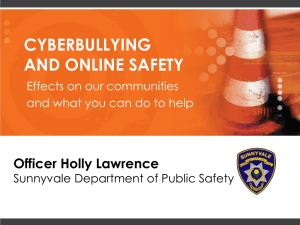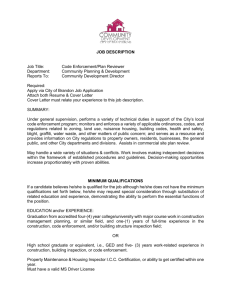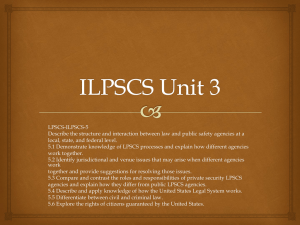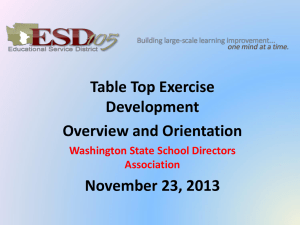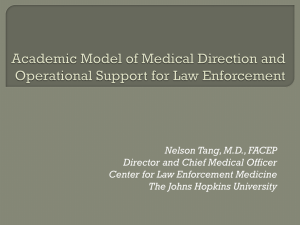Draft Preliminary Safety Policy
advertisement
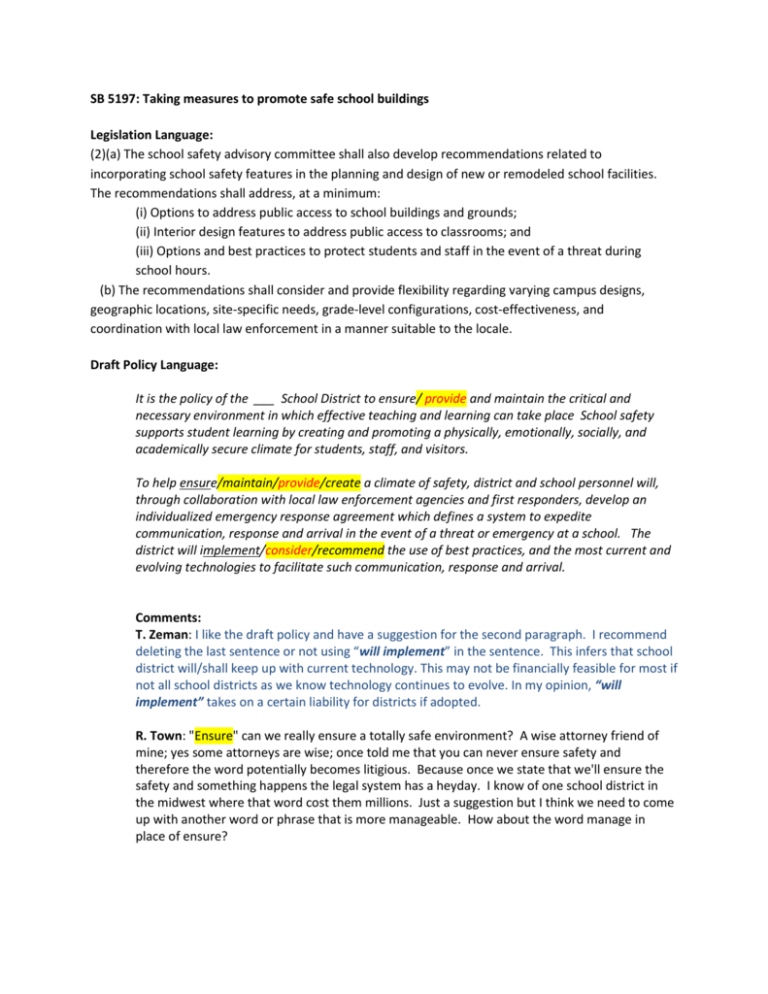
SB 5197: Taking measures to promote safe school buildings Legislation Language: (2)(a) The school safety advisory committee shall also develop recommendations related to incorporating school safety features in the planning and design of new or remodeled school facilities. The recommendations shall address, at a minimum: (i) Options to address public access to school buildings and grounds; (ii) Interior design features to address public access to classrooms; and (iii) Options and best practices to protect students and staff in the event of a threat during school hours. (b) The recommendations shall consider and provide flexibility regarding varying campus designs, geographic locations, site-specific needs, grade-level configurations, cost-effectiveness, and coordination with local law enforcement in a manner suitable to the locale. Draft Policy Language: It is the policy of the ___ School District to ensure/ provide and maintain the critical and necessary environment in which effective teaching and learning can take place School safety supports student learning by creating and promoting a physically, emotionally, socially, and academically secure climate for students, staff, and visitors. To help ensure/maintain/provide/create a climate of safety, district and school personnel will, through collaboration with local law enforcement agencies and first responders, develop an individualized emergency response agreement which defines a system to expedite communication, response and arrival in the event of a threat or emergency at a school. The district will implement/consider/recommend the use of best practices, and the most current and evolving technologies to facilitate such communication, response and arrival. Comments: T. Zeman: I like the draft policy and have a suggestion for the second paragraph. I recommend deleting the last sentence or not using “will implement” in the sentence. This infers that school district will/shall keep up with current technology. This may not be financially feasible for most if not all school districts as we know technology continues to evolve. In my opinion, “will implement” takes on a certain liability for districts if adopted. R. Town: "Ensure" can we really ensure a totally safe environment? A wise attorney friend of mine; yes some attorneys are wise; once told me that you can never ensure safety and therefore the word potentially becomes litigious. Because once we state that we'll ensure the safety and something happens the legal system has a heyday. I know of one school district in the midwest where that word cost them millions. Just a suggestion but I think we need to come up with another word or phrase that is more manageable. How about the word manage in place of ensure? Conversation on Strategies / Procedures / Primer Content: Identify key components of a model emergency response plan for schools/law enforcement o Pre-planned tactical response plan developed collaboratively with local police and fire agency which indicates, at a minimum Entry Team Inner Perimeter Outer Perimeter Incident Command Staging Areas Occupant Evacuation Areas Family Re-unification sites Media Briefing Location o Procedures specific to each school for response to the following emergencies Violent Intruder Neighborhood criminal activity Chemical Spill Fire Emergency Medical Earthquake o Procedures specific to each school for the following responses to emergencies Lockdown Lockout (called Modified Lockdown in many districts) Shelter-in-Place Evacuation Develop the components of the agreement referred to in the draft model policy: a model Memorandum of Agreement/Understanding (MOA/MOU) between the Local Education Agency (LEA) and local law enforcement jurisdiction(s); o Identify the primary law enforcement jurisdiction for each school o Identify the primary fire department jurisdiction for each school o Identify the primary 9-1-1 Public Safety Answering Point (PSAP) for each school o Identify number of School Resource Officers provided by each law enforcement jurisdiction (if any) and which schools they serve o Identify a liaison officer at each law enforcement jurisdiction, one for the district, and (optionally) one at each school o Identify designated (non-commissioned) safety and security staff (if any) at which schools they serve o Agree to a minimum number of drills and exercises in which the primary law enforcement agency will participate each school year o Agree to a minimum number of drills and exercised in which the fire department will participate each school year Create a working definition of “evolving technologies” – one that may vary, based on location; o Alerting systems o Camera systems o Door lock control systems o System integration Clarify legislative vocabulary (for example, “expedited” to mean “effective & timely”); o “Comprehensive school safety plan” means addressing all areas covered by the OSPI School Safety Center Manual o “School mapping information system” means the Critical Incident Planning and Mapping System, operated by the Washington Association of Sheriffs and Police Chiefs (WASPC) and commonly referred to as “Rapid Responder” Incorporate into existing school safety plans, resources and the Safety Planning Manual; Provide for the inclusion and coordination with 911 call centers; o Where the 9-1-1 call center is separate from the law enforcement agency having jurisdiction over the schools, develop MOU / MOA specific to 9-1-1 issues o Identify a liaison officer for the 9-1-1 call center(s) which serve schools in the district Integrate products and processes with current site-based technologies; Integrate all with a district’s current plans, procedures and resources; Generate a primer on school safety based on the definitions, best practices and look-fors. o Cover all areas recommended in the OSPI School Safety Center Manual Generate a list of: o best practice look-fors and to-dos; (What makes a tool, process or product good?) o potential resources: Note: this would not be a recommended list; rather, a starter list so we have an idea of what’s currently out there. o activities and tools to avoid. (What makes a tool, process or product bad?) Also: - 911 – in all MOUs (S. Fritts: 911 centers should be included as signatory agencies to the MOU/MOA. Many 911 centers in the state are independent agencies/jurisdictions and as such should be included as an equal partner in the process. Others may be represented by law enforcement or fire services. Each agreement will likely be slightly different, and should be inclusive of all response agencies and/or jurisdictions. ) - CPTED - Visitor Management - Role, training of SROs / SSOs / other security personnel - Run. Hide. Fight. - Staff training: awareness, recognition, prevention, early intervention, emergency response, postventions. - Sequenced purchase plan – Tiered Planning Guidance: Schools have limited funds. Provide a prioritized list of safety & security purchases/expenditures of what might that look like What might a school or district consider purchasing first? After that? 3rd? And so on. A starter list might include: 1. Safety Evaluation Walk-Through 2. CPTED- informed upgrades/updates a. potentially low cost maintenance work b. High results in terms of safety 3. Visitor badges a. Cheap b. Ensure ID on entry and throughout bldg.. 4. (Improved)Gates & fencing a. Limit access to campus 5. Entrances a. More costly, b. Secure locks; crash bars 6. Main entry point a. Etc….. 7. Window security / reinforcement 8. PA – Voice notification system 9. Cameras 10. Locks / locking devices 11. Exterior lighting 12. All electronic locking systems 13. --14. --15. --16. Dedicated security staff 17. Evolving technologies…..



